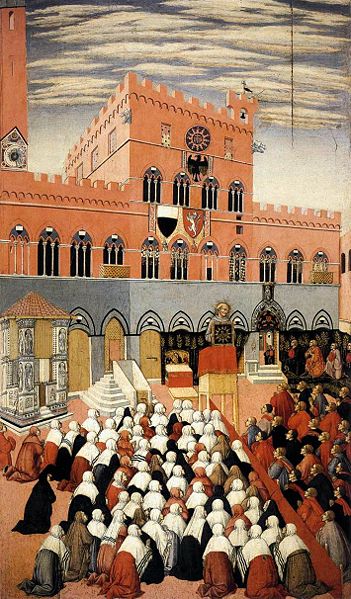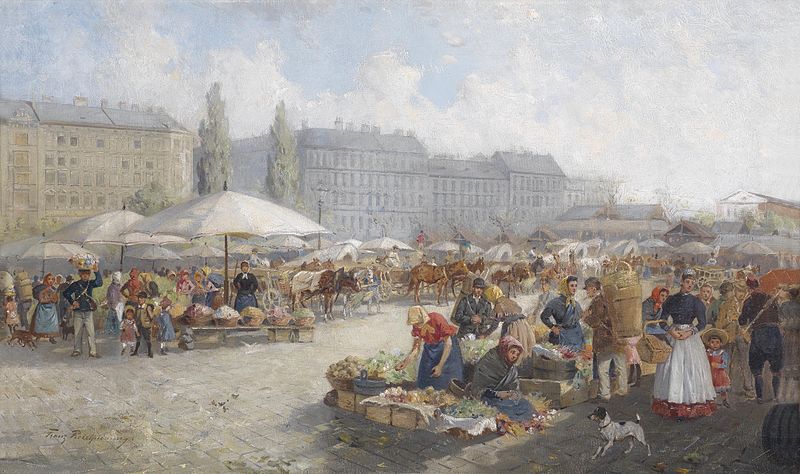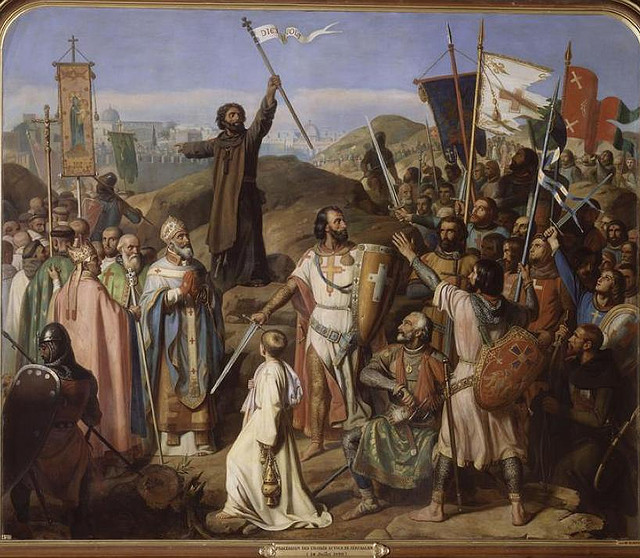
three classes: the clergy, the nobility, and the people.
Painting of the Procession Of Crusaders by Jean-Victor Schnetz
In the Middle Ages, society consisted of three classes, the clergy, the nobility, and the people, each of which had special duties, privileges, and honors.
Besides this tripartite division, a clear distinction existed between rulers and those ruled, a distinction inherent to every social group and principally to a country. Not only the king, however, but also the clergy, the nobility, and the people participated in the country’s government, each one in its own way and measure.
As is well known, both Church and State constitute perfect societies, each distinct from the other and sovereign in its respective field, that is, the Church in the spiritual realm and the State in the temporal. Nonetheless, this distinction does not prevent the clergy from participating in the government of the State. In order to clarify this point, it is fitting to recall in a few words the specifically spiritual and religious mission of the clergy.
From the spiritual point of view, the clergy is the ensemble of people in the Church who have the mission to teach, govern, and sanctify, while it is for the faithful to be taught, governed, and sanctified. Such is the hierarchical order of the Church. The documents of the Magisterium establishing this distinction between the teaching Church and the learning Church are numerous. For example, Saint Pius X affirms in his encyclical Vehementer nos:
“Scripture teaches us, and the tradition of the Fathers confirms the teaching, that the Church is the Mystical Body of Christ, ruled by the Pastors and Doctors—a society of men containing within its own fold chiefs who have full and perfect powers for ruling, teaching and judging. It follows that the Church is essentially an unequal society, that is, a society comprising two categories of persons, the pastors and the flock, those who occupy a rank in the different degrees of the hierarchy and the multitude of the faithful. So distinct are these categories that with the pastoral body only rests the right and authority for promoting the end of the society and directing all its members toward that end; the one duty of the multitude is to allow themselves to be led, and, like a docile flock, to follow the pastors.” (1)
This distinction between hierarchy and faithful in the Church, between rulers and those ruled, is also affirmed in more than one document of the Second Vatican Council.
“Therefore, by divine condescension the laity have Christ for their brother…. They also have for their brothers those in the sacred ministry who, by teaching, by sanctifying, and by ruling with the authority of Christ so feed the family of God (Lumen Gentium, 32).
“With ready Christian obedience, laymen as well as all disciples of Christ should accept whatever their sacred pastors, as representatives of Christ, decree in their role as teachers and rulers in the Church (Lumen Gentium, 37).
“The individual bishops, to each of whom the care of a particular church has been entrusted, are, under the authority of the Supreme Pontiff, the proper, ordinary and immediate pastors of these churches. They feed their sheep in the name of the Lord, and exercise in their regard the office of teaching, sanctifying, and governing (Christus Dominus, 11).” (2)

Consecration of the Bishop of Münster, Bishop Clemens August Graf von Galen, accompanied by His Eminence Cardinal Schulte of Cologne, Bishop Bornewasser of Trier and State Dr. William Berning-Osnabrück in solemn procession from the Bishop’s Palace to the Cathedral.
Through the exercise of the sacred ministry, the clergy bears the lofty and specifically religious mission of providing for the salvation and sanctification of souls. This mission produces a supremely beneficial effect on temporal society, as it always has and always will until the end of time, since sanctifying souls amounts to imbuing them with the principles of Christian morals and guiding them in the observance of the Law of God. Peoples receptive to this influence of the Church are ipso facto ideally disposed to direct all their temporal activities to the attainment of a high degree of competence, efficacy, and prosperity.
Saint Augustine’s famous image of a society whose members are all good Catholics speaks for itself.
“Therefore, let those who say that the teaching of Christ is contrary to the State provide such an army as the teaching of Christ orders soldiers to be; let them provide such governors, such husbands, such wives, such parents, such children, such masters, such servants, such kings, such judges, and lastly such taxpayers and tax collectors as Christian teaching admonishes them to be; and then let them dare to say that this teaching is opposed to the welfare of the State, or, rather, let them even hesitate to admit that it is the greatest safeguard of the State when faithfully observed.” (3)
Under this perspective, it is proper for the clergy to firmly establish and maintain the moral foundations of the perfect civilization, the Christian one. By a natural connection, in the Middle Ages, education and works of public assistance and charity were entrusted to the Church. The Church performed these services, normally the purview of the departments of education and public health in contemporary secular states, without burden to the public coffers.
It is understandable then that the clergy was recognized as the first class in the Middle Ages, due to the supernatural and sacred character of its spiritual mission, and also to the beneficial effects its proper exercise produced in temporal society.
On the other hand, the clergy, in the exercise of its sublime mission, apart from any temporal or terrestrial power, is an active factor in the formation of the nation’s spirit and mentality. Between clergy and nation, there normally exists an exchange of understanding, trust, and affection that apportions to the former unmatched possibilities to know and orient the aspirations, concerns, sufferings, in short, the spiritual life of the population, as well as the temporal affairs that are inseparable from it. To accord the clergy a voice and a vote in the great and decisive national assemblies is, therefore, an invaluable way for the State to ascertain the yearnings of its people.
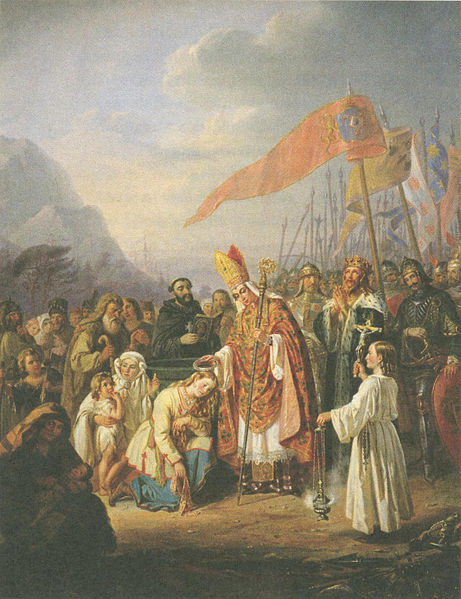
St. Henry, Bishop of Upsala, baptizes the Finns at the spring of Kuppis, close to Turku. The monarch pictured here is King Eric the Saint of Sweden. Painting by R.W. Ekman.
Hence it is understandable that throughout history clerics, although maintaining their alterity in relation to the political life of the country, have frequently been heeded and respected counselors of the public power and valuable participants in the development of certain legislative matters and governmental policies.
But the picture of relations between the clergy and the public power is not limited to this.
The clergy is not a group of angels living in Heaven, but of men who exist and act concretely on this earth as God’s ministers. The clergy comprises part of the country’s population, before which its members have specific rights and duties. The protection of these rights and the proper fulfillment of these duties are of utmost importance for both Church and State, as Leo XIII eloquently stated in the encyclical Immortale Dei. (4)
All this indicates that the clergy is distinct from the other elements of the nation. It is a perfectly defined social class that is a living part of the national body and, as such, has the right to a voice and a vote in its public life. (5)
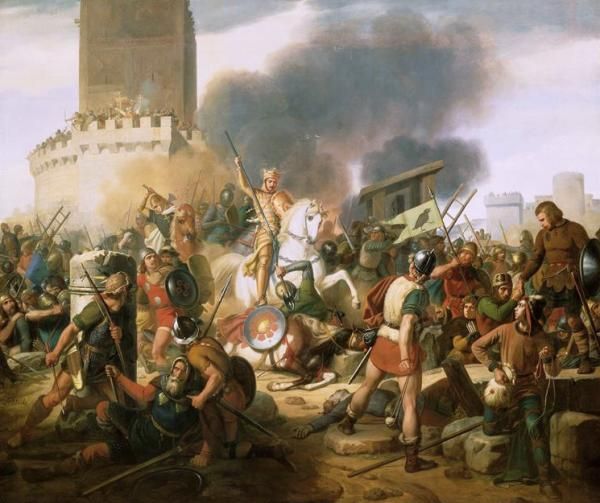
Eudes I, Capetian King of France, then Count of Paris, defending Paris against Norman invasion. Painting by Jean Victor Schnetz.
After the clergy, the second class was the nobility. Essentially it had a military and warrior character. The nobility was responsible for defending the country against external aggression and for keeping the political and social order. Besides that, in their respective domains, the feudal lords cumulatively exercised, without cost to the Crown, functions somewhat analogous to those of our judges, police chiefs, and city council presidents.
Thus, these two classes were essentially ordained toward the common good and, in compensation for their weighty and important charges, they were entitled to corresponding honors and privileges, among which was exemption from taxes.
Lastly, there was the people, a class devoted specifically to productive work. It had, by right, a much lesser participation in war than the nobility and, in most cases, exclusive right to the exercise of the most profitable occupations, such as commerce and industry. Normally its members had no special obligation toward the State. They worked for the common good only in so far as it favored their own personal and familial interests. Thus, this class was not favored with special honors and had to carry the burden of taxes.
(1) American Catholic Quarterly Review, Vol. 31, no. 122 (April 1906), pp. 213-214.
(2) The Documents of Vatican II (New York: America Press, 1966), 59, 64, 403. Reprinted with permission of America Press, Inc., 105 West 56th St., New York, N.Y. 10019, copyright © 1966 All Rights Reserved.
(3) Epist. 138 ad Marcellinum, Chap. 2, no. 15, Opera Omnia, Vol. 2, in J.P. Migne, Patrologia Latina, col. 532.
(4) “There was once a time when states were governed by the principles of Gospel teaching. Then it was that the power and divine virtue of Christian wisdom had diffused itself throughout the laws, institutions, and morals of the people; permeating all ranks and relations of civil society. Then, too, the religion instituted by Jesus Christ, established firmly in befitting dignity, flourished everywhere, by the favor of princes and the legitimate protection of magistrates; and Church and State were happily united in concord and friendly interchange of good offices. The State, constituted in this wise, bore fruits important beyond all expectation, whose remembrance is still, and always will be, in renown, witnessed to as they are by countless proofs which can never be blotted out or even obscured by any craft of any enemies.” (Rev. John J. Wynne, S.J., ed., The Great Encyclical Letters of Pope Leo XIII [New York: Benziger Brothers, 1903], 118-119.)
(5) Another aspect of the clergy’s legitimate participation in public life in feudal times was the existence of dioceses and abbeys whose titulars were, at the same time and by the very fact, lords of the respective feudal domains. For example, by virtue of being bishops and regardless of their social origin, the Bishop-Princes of Cologne and of Geneva were princes of their respective cities. Among the latter was Saint Francis de Sales, an eminent Doctor of the Church. Along with the Bishop-Princes there were other ecclesiastical dignitaries on whom titles of lesser rank were conferred. Two examples in Portugal were the Archbishops of Braga, who were also lords of that city, and the Bishops of Coimbra, who were ipso facto Counts of Arganil (ever since Dom Afonso V graced the 36th Bishop of Coimbra, Dom João Galvão, with this title in 1472), whence the title Bishop-Count of Coimbra.
Plinio Corrêa de Oliveira, Nobility and Analogous Traditional Elites in the Allocutions of Pius XII: A Theme Illuminating American Social History (York, Penn.: The American Society for the Defense of Tradition, Family, and Property, 1993), 31-35.
